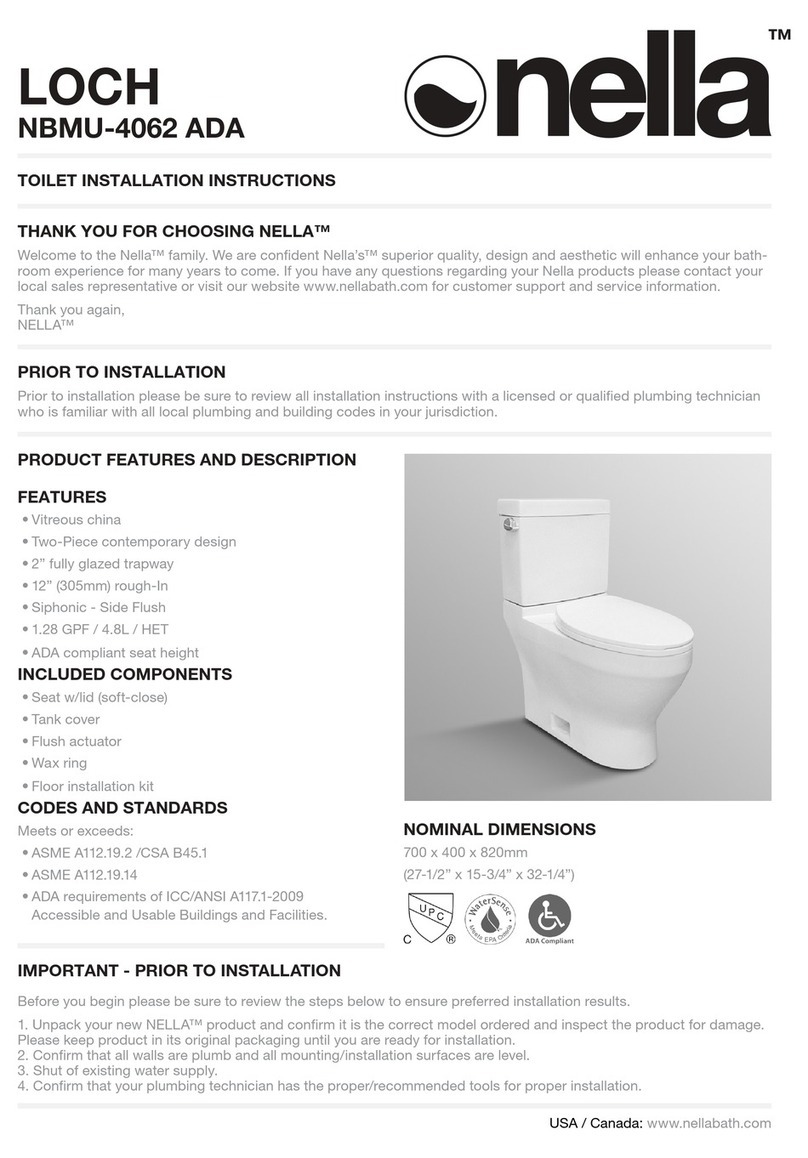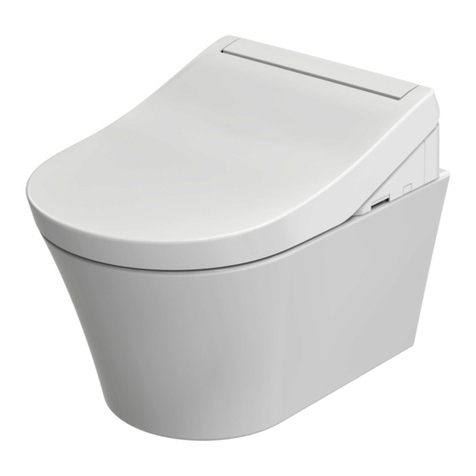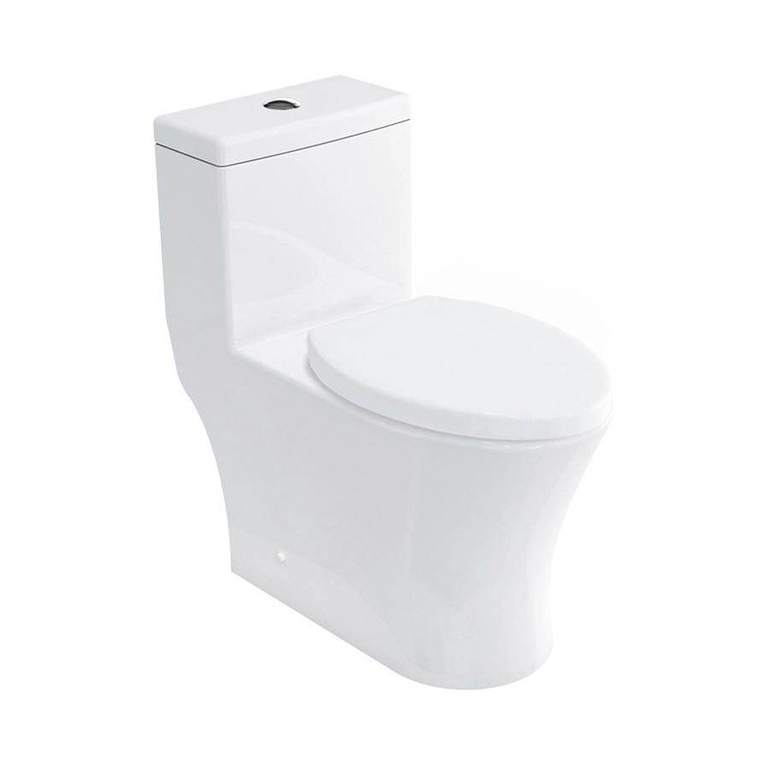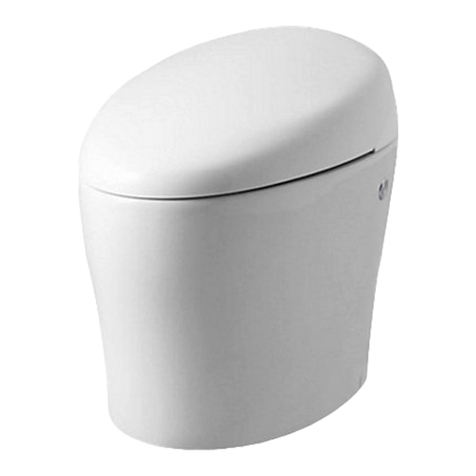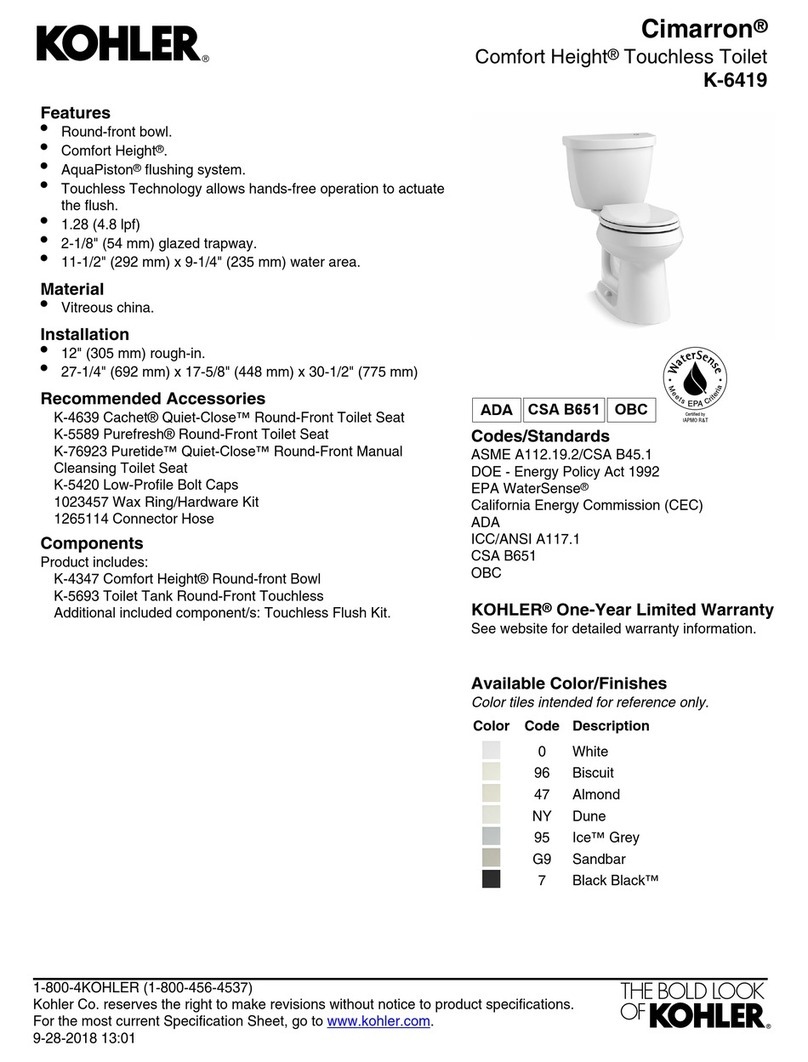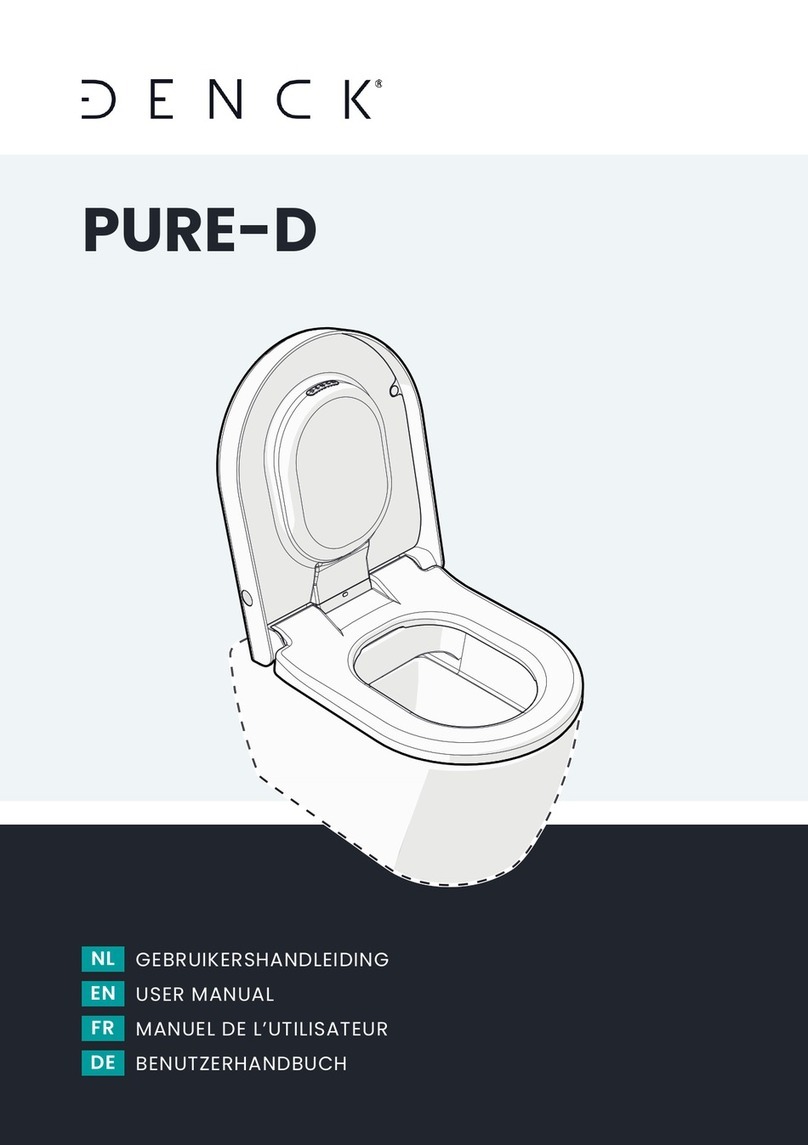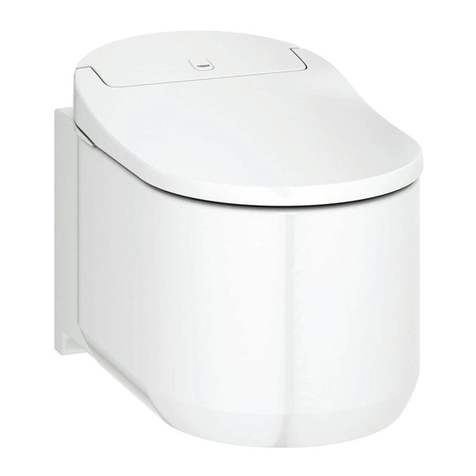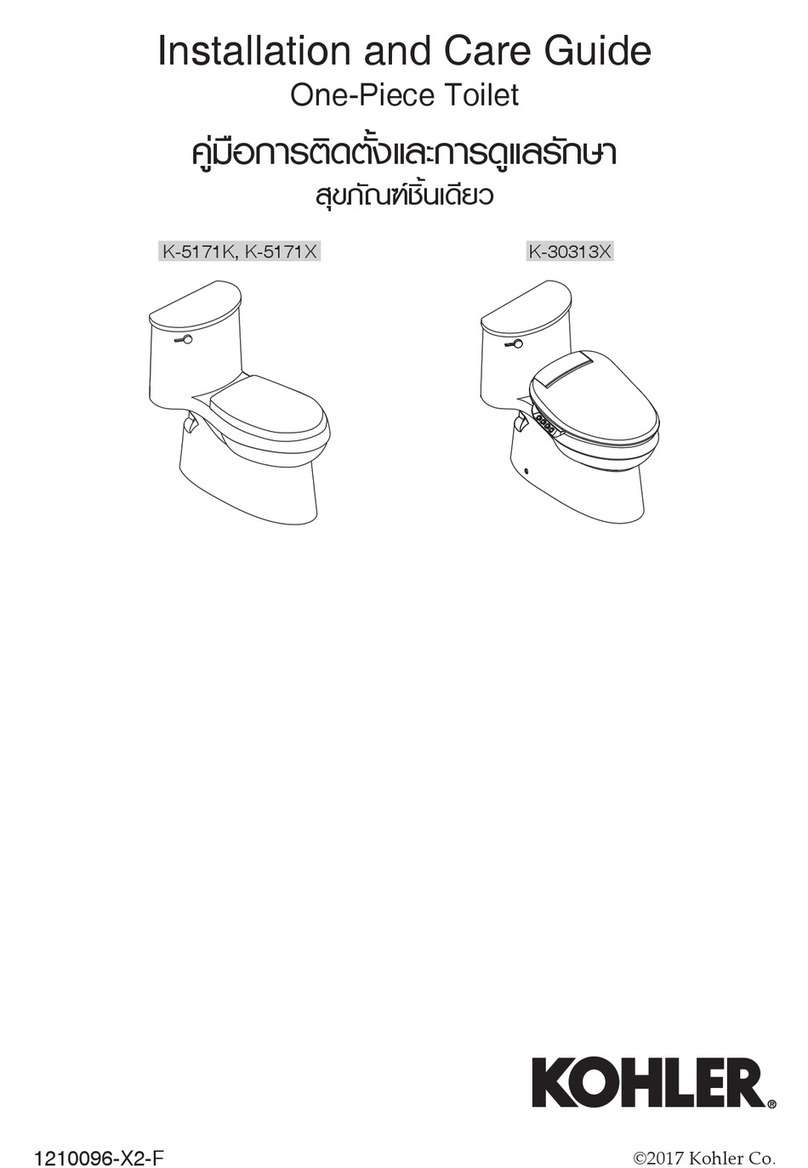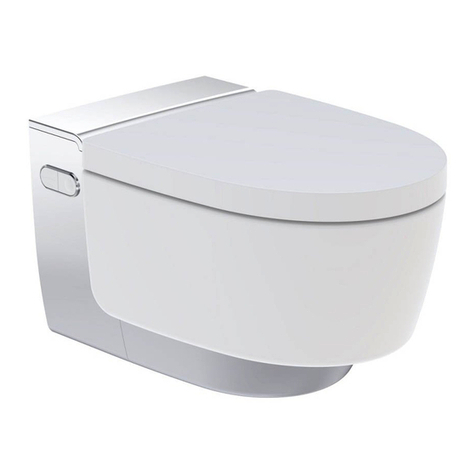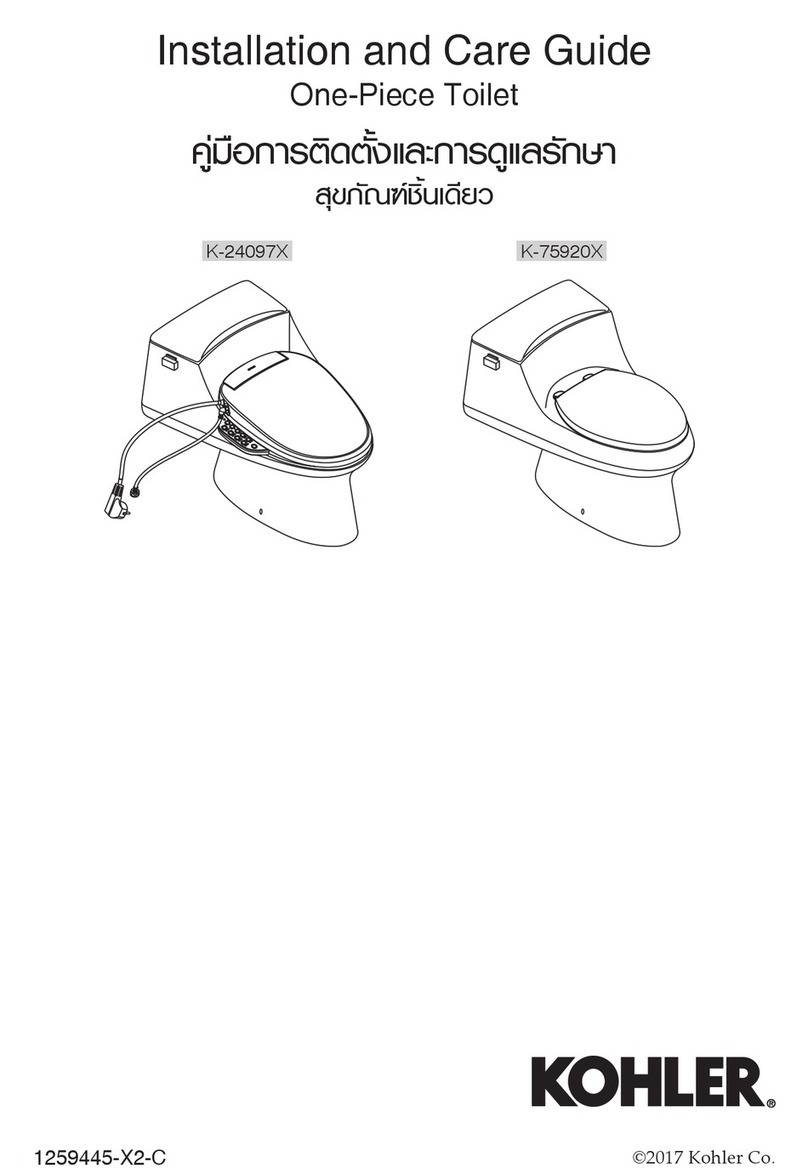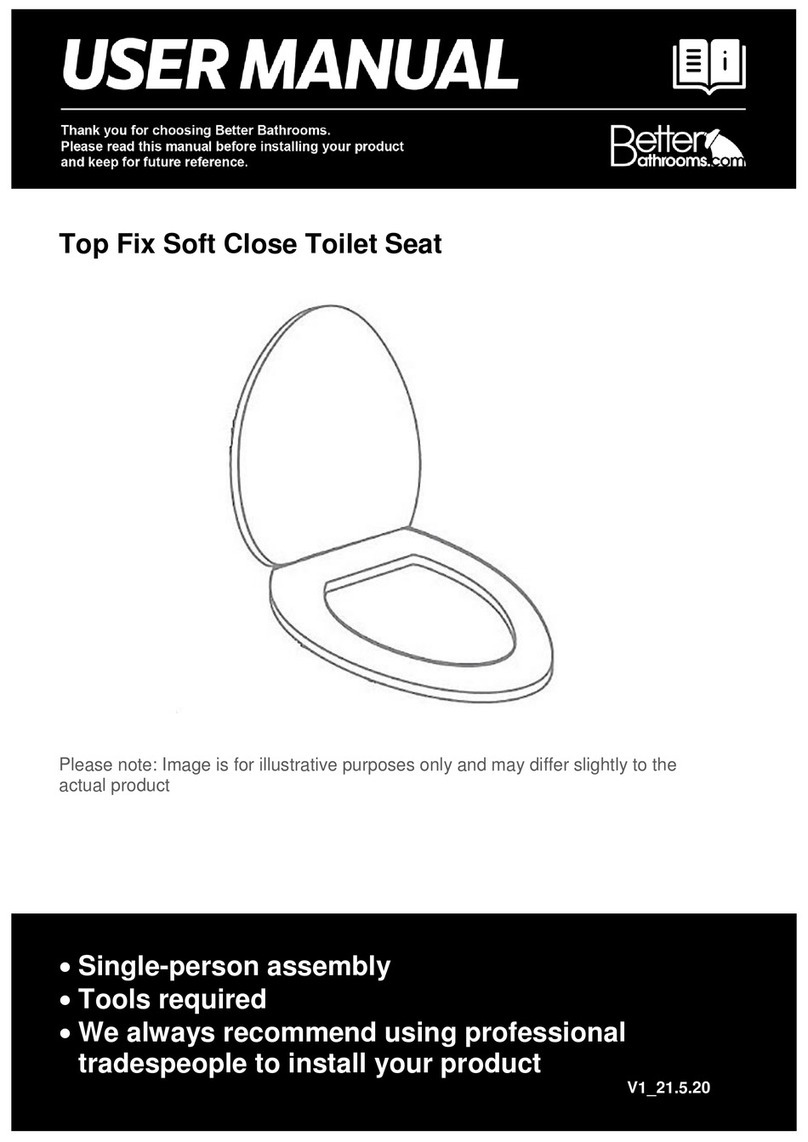SPX FLOW Johnson Pump AquaT Comfort User manual

AquaT Manual marine toilet- Instruction manual
English
Original instructions
Applications
SPX FLOW Johnson Pump Comfort and Compact bowl manually operated
marine toilets can be installed in both power and sailing craft, either above
or below the waterline, for use on sea, river, lake or canal.
The waste can be discharged either overboard (please have in mind
national or local restrictions), or into a treatment system or into an on-board
holding tank.
Note: SPX FLOW Johnson Pump manual toilets are designed specifically
for marine use. Consult your SPX FLOW Johnson Pump retailer for advice
about possible non-marine applications.
Features
Design
• Flexible hole pattern on the base, for easy substitution with the
most common toilets on the market
• Reversible pump mounting allows re-assembly for left hand
operation by installer
• Self-priming, double acting piston pump
• Piston rod guide in brass for increased service life
• Strong swirl action for efficient flushing
• Smooth design for easy cleaning
• Ergonomic handle
• Spring assisted top valve closure for easier priming
• Constant 38mm (1 1/2") bore waste path minimizes blockages
• Double check-valves at full 38mm (1 1/2") bore prevent back flow
• Multi-angle outlet for various installations
• Accessible mounting points for faster installation
• Standard fastenings, logic located, no need for special tools
• Double sealed base plug for winter drain and easy cleaning
access
Material
• Plastic seat made of polypropylene
• Hygienic white ceramic bowl for ease of cleaning
• Pump and base moulded in ABS or polypropylene, stainless steel
fastenings, brass weights and neoprene seals and gaskets
Performance
• Self priming, dry, height 1m (3ft)
• Discharge height 3m (9ft)
Dimensions
• Dimensional Drawing on the page 14.
Installation instructions, General
Through hull fittings
You need:
19 mm. (3/4”) bore seacock for the flushing water inlet and, if you are dis-
charging overboard, a 38 mm. (1 1/2”) bore seacock for the waste outlet.
• Keep to the seacock manufacturer’s instructions concerning
materials and methods of installation
• Ensure that the inlet seacock is positioned where it will be below
the waterline at all times when the craft is under way and also
ensure that any outlet seacock is both aft of, and higher than the
inlet seacock
Pipework -selection of the correct method
You must select the correct installation method for the inlet pipework from
2 possibilities and for the outlet pipework from 4 possibilities, accord-
ing to whether the toilet is above or below the waterline and to whether it
discharges the waste overboard or into an on-board holding tank.
General instructions for all possible
installations
You need:
• Spiral reinforced smooth bore flexible hose for both the 19 mm.
(3/4") internal diameter inlet and the 38 mm (1 1/2") internal
diameter outlet hose
• Stainless steel hose clip
• Secure the hose runs so that the hoses cannot move, nor exert
any leverage action on the hosetail fittings to which they are
connected, as this may cause adjacent joints to leak.
• Avoid sharp bends in the hoses since this might cause them to
become kinked
• Keep all pipework lengths as short as possible while you are
carrying out these operations Unnecessary inlet or outlet hose
lengths just make the toilet harder to pump.
Tip: Should it be difficult to fit the hose onto the hose tails of the toilet or
the sea cocks, soften the hose by dipping its end in hot water
CAUTION:
• Do not apply flame to hoses
• Do not apply flame or heat to the plastic hose tails of the toilet
• Do not apply sealing compounds to any hose connection
• Secure all hose ends to the hose tails with preferably two stainless
steel clips, ensuring that all inlet connections are airtight and that
all outlet connections are watertight.
• The discharge elbow may be rotated 360 deg. to suit your in-
stallation. Always slacken the 2 securing screws, adjust the
discharge elbow to the required position and retighten the 2
securing screws before connecting the hose to it
CAUTION:
Failure to follow this procedure may cause leaks between the elbow and
the pump cylinder
Pipework – Inlet
Alternative 1
Toilet below the waterline
You must use a 19 mm (3/4”) Vented Loop fitting.
• Run the inlet hose by the most direct way from the inlet seacock
to the flushing pump inlet tail.
• Remove the white hose supplied with the toilet which connects
the flushing pump outlet tail to the bowl elbow
• Using a spanner, rotate the intake seal so that the elbow points
upwards
• Replace the white hose with a longer length of 19 mm internal
diameter hose and position it in a way that its point is at least
20 cm (8”) above the highest possible waterline and fit the vented
loop at that highest point
CAUTION:
Do not position the vented loop between the inlet seacock and the flushing
pump inlet, as it will make the flushing pump difficult or harder to prime, and
could prevent it from working at all.
Instruction manual- AquaT Manual marine toilet

English
Original instructions
Alternative 2
Toilet above the waterline
You may use a 19 mm. (3/4”) non-return valve
• Run the inlet hose by the most direct route from the inlet seacock
to the flushing pump inlet tail
• For your maximum convenience of use, install an in-line non-
return valve next to the inlet seacock which will ensure that the
pump stays primed in between usages.
• The toilet flushing pump will self-prime up to 1m (3’) above the
outside water level. If there is any possibility that the toilet flushing
pump inlet may be more that 1m (3’) above the actual waterline
when the craft is underway, a non-return valve is to be installed
next to the seacock to maintain the pump in a primed condition
Pipework – Outlet
Alternative 1
Toilet below the waterline and discharging over-
board
Fig. 1
Toilet below the waterline
You must use a 38mm (1 1/2”) Vented Loop fitting.
• Arrange the outlet hose, so that its highest point is at least 20 cm
(8”) above the waterline, and fit the Vented Loop at the highest
point.
Alternative 2
Toilet above the waterline and discharging over-
board
Fig. 2
Toilet above the waterline
You may use a 38mm (1 1/2”) Vented Loop fitting.
• Run the outlet hose up from the discharge elbow, at least 30 cm
(12’) above the discharge elbow then fit a Vented Loop on top of
the hose, ensuring in this way to keep some water in the base of
the toilet without risk of it being siphoned away
Alternative 3
Toilet waste discharging into holding tank, dis-
charge elbow below top of holding tank at any
time
You must use a 38 mm (1 1/2”) Vented Loop fitting
• If the discharge elbow is placed less than 20 cm (8”) below the
top of the holding tank when the craft is at rest, or if there is any
possibility that the discharge elbow may be below the top of the
tank at any time, a vented loop must be fitted in the outlet pipe-
work
• Place the outlet hose point at least 20cm (8”) above the highest
level that the top of the tank may reach and install the Vented Loop
fitting on this highest point
Alternative 4
Toilet waste discharging into holding tank, dis-
charge elbow always above top of the holding
tank
You may use a 38mm (1 1/2”) Vented Loop fitting
• Run the inlet hose upwards from the discharge elbow, to form a
loop at least 30 cm (12”) higher than the discharge elbow.
• By fitting a Vented Loop on top of the hose loop, you will ensure
to keep some water in the base of the toilet without risk of it being
siphoned away.
Testing
Refer to the operating instructions and follow the procedures for normal
use.
In case the flushing pump is hard to prime, half-fill the bowl with fresh water

AquaT Manual marine toilet- Instruction manual
English
Original instructions
Safety
Ensure that these instructions reach the owner, the skipper or the operator
of the craft, as it contains important safety information on completion of
Installation:
Shut the flush control
Close both seacocks
Installation instructions
Introduction
If the installation of the toilet results in being connected to any through-hull
fitting that may possibly be below the waterline whether when the craft is
at rest, underway, heeling, rolling or pitching, you must install the toilet in
accordance with the present installation instructions.
Failure to follow such instructions may cause water to flood in, which may
result in loss of life.
ACCIDENTAL DAMAGE
If the toilet is connected to any through-hull fitting and if the toilet or the
pipework are damaged, water may flood in, causing the craft to sink with a
consequent possible loss of life. For this reason, if you are making connec-
tions between the toilet and any through hull fitting that may be possibly
situated below the waterline, fullbore seacocks must be fitted to such hull-
fittings, to allow them to be shut off.
The seacocks must also be positioned where they are easily accessible to
all users of the toilet.
If, for any reason, it is not possible to do it, then secondary full-bore marine
quality valves must be fitted to the hoses where they are easily accessible
CAUTION:
Use seacocks! Use lever operated, full-bore marine seacocks and valves.
The use of screw-down gate valves is not recommended.
Pipework loosing
All pipeworks must be fastened both in the gate side and in the remain-
ing ones with a stainless steel hose clamp. Please keep in mind that an
eventual leak might cause the craft to sink, with consequent loss of life use
hose clamps!
Bowl rim below the waterline
If the toilet is connected to any through-hull fitting and if the rim of the bowl
falls below the waterline, water may flood in, causing the craft to sink, which
may result in loss of life. Therefore, if the rim of the toilet is less than 20 cm
(8”) above the waterline when the craft is at rest, or if there is any possibility
that the rim of the bowl may be below the waterline at any time, a vented
loop must be fitted in any pipework connected to a through-hull fitting,
irrespective of whether inlet or outlet.
Use vented loops!
Special notes: The smaller bore inlet pipework is more dangerous than the
larger outlet one. Unless there is a ventilated anti-siphon loop in the inlet
pipework, water will flow into the bowl whenever both the inlet seacock is
opened and the rim of the bowl is below the actual waterline.
Although moving the flush control lever to the “Shut” position will restrict
the flow, this lever cannot be relied upon as a safety device. To make a loop
in the hose without mounting a vent may be as hazardous as no loop at all,
because water will siphon over the loop.
In fact, it is the vent that actually prevents the siphon.
Location
The toilets base and pump is supplied assembled for a right handed
operation. If you wish, both comfort and compact bowl models may be
reassembled with the pump positioned on the left hand side. The bowl and
the base/pump unit are not assembled. If you want to change the pump
mounting from right to left hand, do so before installing the toilet.
Change to left hand operation
1. Pull off the hose that runs from the pump to the bowl.
2. Remove the 4 screws that secure the pump assembly to the base.
3. Lift off the pump assembly and leave the base valve gasket on its
3 locating pegs.
4. Remove the 4 bolts that secure the bowl to the base.
5. Rotate the bowl 180° and re-secure it, using the nylon washers to
protect the ceramic from the stainless steel washers and nuts.
6. Rotate the pump assembly 180° and re-secure it.
7. Rotate the push-fit intake elbow 180° and refit the hose between
the pump and the bowl.
Assemble the bowl on the top of the base, using the attached bolts, wash-
ers and gaskets. The nylon washers are to protect the ceramic from the
stainless steel washers and nuts.
• choose a location which will give enough clearance all around and
above the toilet. Ensure that there is room to operate the pump and
that there is access to the drain plug at the end of the base.
• the mounting surface must be flat, rigid, and strong enough to
support a man’s weight and should be at least 50 mm (2”) wider
and 50 mm (2”) deeper than the base of the toilet.
• you will need sufficient clearance below the mounting surface to
be able to secure the mounting bolts
• the seat and the lid should be able to swing open at least 110
degrees, in order they will not fall forward when the craft heels or
pitches. When they are swung open, they must be supported so
that the hinges are not strained.
Mounting
You need
• Stainless steel screws: 4 pcs, 8mm (5/16”) diameter of length to
suit the thickness of the mounting surface.
• Stainless steel nuts: 4 pcs preferably self-locking. If you do not
use self-locking nuts you need to add locking compound on the
screws / nuts.
• Stainless steel washers: 8 pcs, large diameter, but not more than
21 mm (13/16”) diameter.
• Drill: Diameter 9mm.
• Silicone sealant, white.
If you do not use self-locking nuts, you will need some nut-locking com-
pound

English
Original instructions
1. Put the toilet in the selected position. Using the holes in the base
as a guide, mark the positions for the 4 screws holes on the mounting
surface. Remove the toilet and drill 4 vertical holes, with a dia-
meter of 9mm, through the mounting surface.
2. Apply the white silicone sealant to the outer rim of the bottom
base.
3. Put the toilets on its place and tighten the fastenings securely. If
you are not using self-locking nuts, use nutlocking compound.
Operating instructions
The toilet is one of the most used pieces of equipment on your boat. Cor-
rect operation of the toilet is essential for the safety and comfort of your
crew and craft.
HAZARD RISK:
Accidental Damage
If the toilet is connected to ANY through-hull fittings that are below the
waterline at any time, and if the toilet or pipe-work is damaged, water may
flood in, causing the craft to sink, which may result in loss of life.
Therefore, after every usage; both seacocks (or secondary valves) MUST
be shut.
Whenever your craft is unattended, even if only for a very short period of
time, both seacocks (even if secondary valves are fitted) MUST be shut
Ensure that ALL users understand how to operate the toilet system cor-
rectly and safely, including seacocks and secondary valves
Take special care to instruct children, the elderly and visitors
Absolutely shut seacocks!
First use
After periods without use the toilet may benefit from lubrication
1. Open inlet and outlet seacocks (and secondary valves if fitted)
2. Half fill the bowl with warm fresh water
3. Keeping the Flush Control Lever in the “Shut position”, pump out
the warm water
Normal Use
Open inlet and outlet seacocks (and secondary valves if fitted).
• Before use, ensure that there is enough water in the bowl to pre-
vent the toilet paper becoming compacted at the bottom of the
bowl. If the bowl is empty, move the Flush Control Lever to the
“Open position” and pump the handle up and down until the flush-
ing pump is primed and water enters the bowl, then shut the
“Flush Control”.
• Operate the pump with long, smooth strokes for efficient and easy
operation.
• During use, pump as necessary to keep the contents of the bowl
low enough for comfort.
• Use good quality hard or soft household toilet paper, but do not
use more than necessary.
• After use, keep the Flush Control Shut ( ) and pump until the
bowl is empty.
• When the bowl is empty, Open the Flush Control ( ) again,
and continue to pump until all waste has either left the boat, or
reached the holding tank (allow 7 complete up/down strokes per
meter length of discharge pipe-work.
Afterwards, shut ( ) the Flush Control and pump until the bowl is
empty, Always leave the bowl empty to minimise odour and spillage
After use:
• Shut the flush control. ( )
• Shut both seacocks
NOTE: Do not put any of the following into the toilet: Sanitary
Towels, Wet Strength Tissues, Cotton Wool, Cigarettes, Matches,
Chewing Gum or any solid objects, Petrol, Diesel, Oil, Solvents of
any kind or water more than hand warm.
Cleaning
A regular flushing with clean (sea)-water represents one of the most effec-
tive methods to keep the toilet clean and good smelling.
• To clean the bowl, use any liquid or cream ceramic cleaner
• To clean the rest of the toilet, including the seat and lid, use a non-
abrasive liquid cleaner Polish with a dry cloth only.
• To disinfect the toilet, use a liquid disinfectant diluted in accord-
ance with the manufacturer’s instructions. It is possible to apply it
to all parts of the toilet using a sponge or soft brush as necessary.
• After applying any cleaning or disinfecting agent, always flush
well. Do not allow these agents to stand in the System.
CAUTION:
•Do not use abrasive pads on any part of the toilet and do not use
cream cleaners except for the bowl.
•Do not use thick liquid toilet cleansers or neat bleach because
they may damage the valves, gaskets and seals.
Maintenance instructions
Introduction
SPX FLOW Johnson Pump marine toilets normally do not require mainte-
nance during the season, provided that they are winterized in the autumn
and overhauled in the spring.
However, any toilet will benefit from:
Thorough flushing (refer to the operating instructions for normal use).
Regular use if not regularly used, lubrication is beneficial (refer to the oper-
ating instructions for the first use)
HAZARD RISK LEAKS:
If the toilet is connected to any through-hull fittings, and if the toilet or the
pipework develops a minor leak, this leak can suddenly become a bigger
leak which will allow water to flood in, causing the craft to sink, with subse-
quent loss of property and life.
Therefore, in case any leak develops, repair it immediately! Moreover, regu-
larly inspect all fastenings to check tightness and leaks.
Service
Preparation for winterization
SPX FLOW Johnson Pump manual toilets are design to be simple to
service; therefore no special skills are needed, as well as no special tools
are required.
• Flush the toilet according to the operating instructions for normal
use and particularly ensure that all waste has left the discharge
pipework, that the bowl is empty and that both seacocks are
closed (even though secondary valves are fitted)
• Mop-up any water which might come out of the system
Seal replacement
If water begins to leak round the piston rod on top of the pump, it means
that the seal assembly is worn out and should be replaced.
To this purpose, you will have to act as follows:
You will need a “Gasket kit”
• Raise the handle to the top of its travel and wrap one turn of tape
around the piston rod immediately below the handle. Using pliers,
grip the piston rod only through the tape, unscrew the handle and
remove the bumper washer. KEEP HOLD OF THE PISTON ROD AS
LONG AS THE OPERATION HAS BEEN COMPLETED, since if you
let it go, it might fall inside the pump.
• Unscrew the seal assembly and slide it off the piston.
• Wrap one turn of tape around the thread at the top of the piston
rod to protect the new seal, slide the new seal down the piston rod
and tighten it.
• Remove the tape from the thread.
• Replace the bumper washer and the handle, absolutely by gripping
the piston rod through the tape.
• Remove the tape from the piston rod.
This manual suits for next models
2
Table of contents
Other SPX FLOW Toilet manuals
Popular Toilet manuals by other brands

American Standard
American Standard CONCEPT Cube TF-2704 installation manual
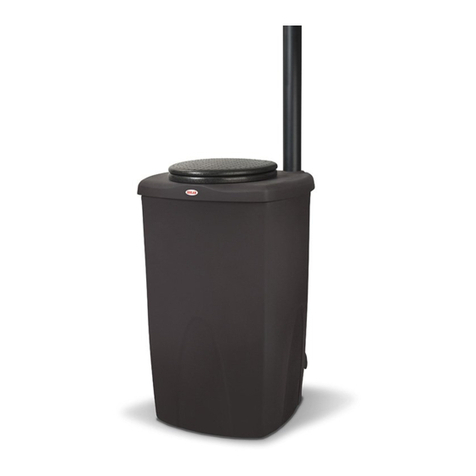
BIOLAN
BIOLAN ECO Instructions for installation, use and maintenance
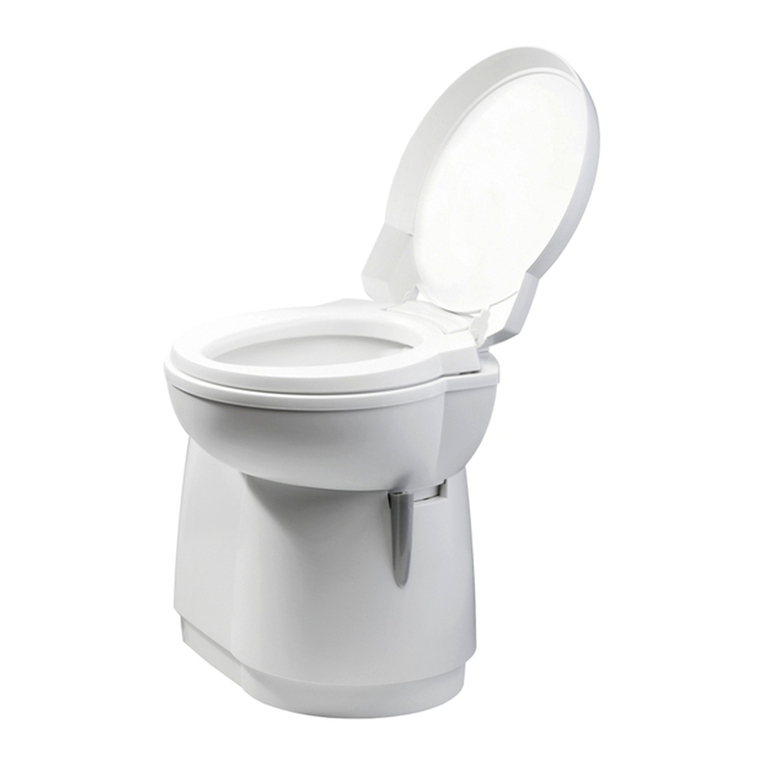
Thetford
Thetford C260 Series user manual
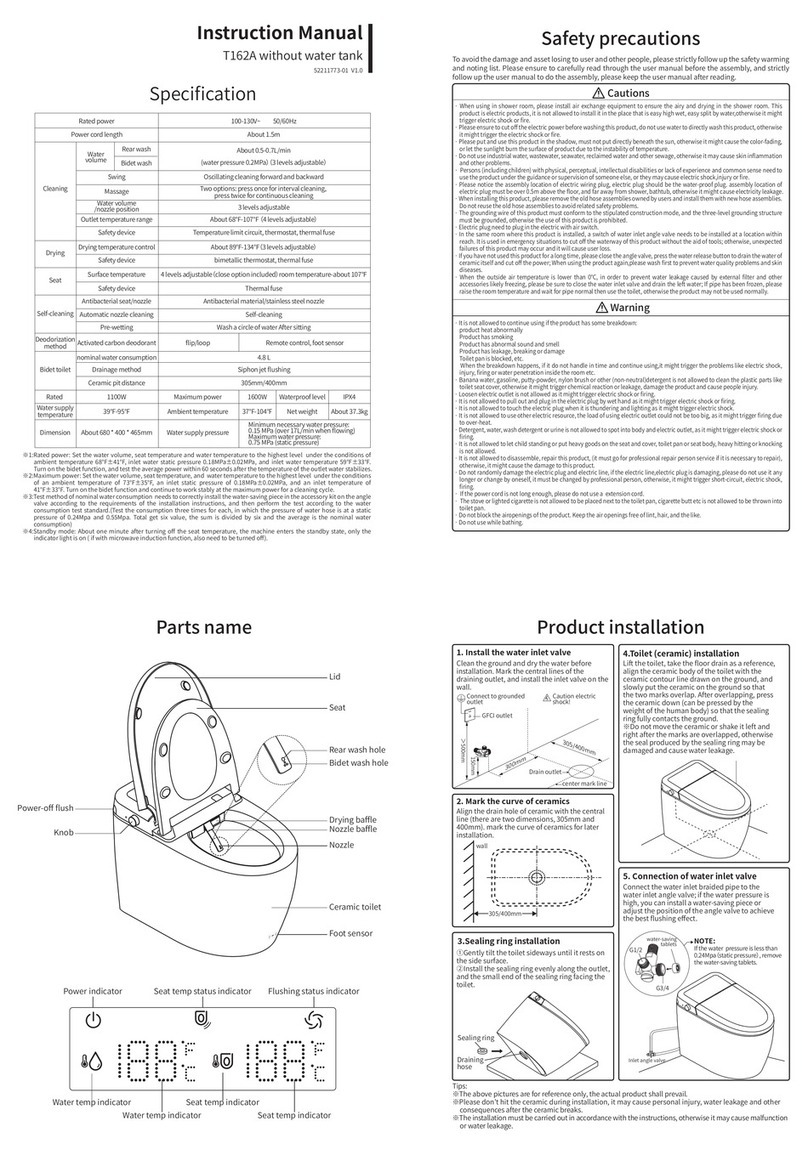
KELISS
KELISS T162A Series instruction manual
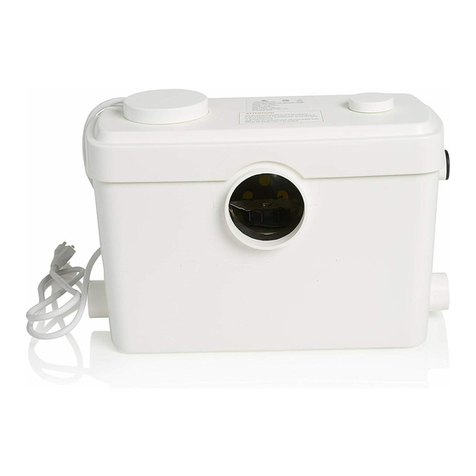
Silent Venus
Silent Venus SVP600 Installation & maintenance
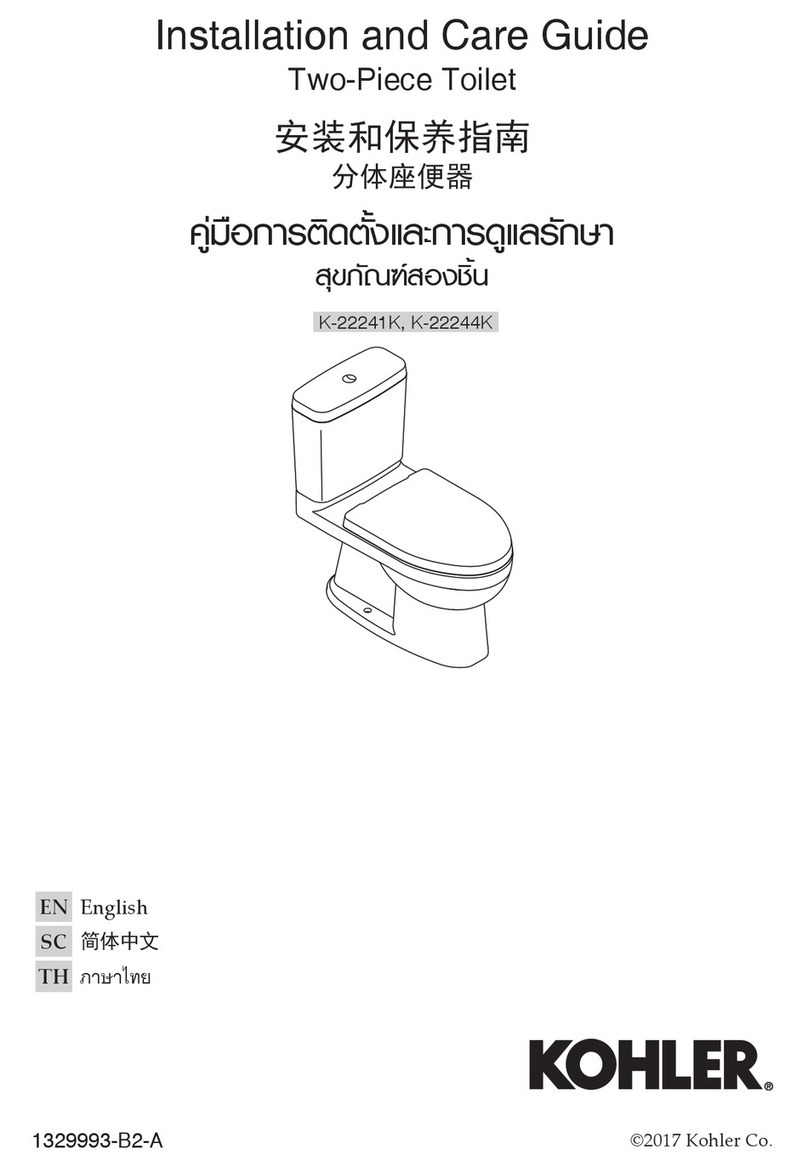
Kohler
Kohler K-22241K Installation and care guide


